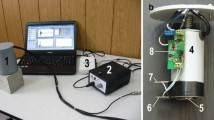Abstract
We present results of studying the spatial variation of parameters of the electrical response to a weak impact under stepwise loading of concrete beams reinforced with steel rods. It is proposed to use the following diagnostic parameters to characterize the presence of a defective area in reinforced beams: the maximum coefficient of correlation between the spectrum of electrical signal after stepwise loading and the original spectrum; the frequency shift for which the maximum correlation coefficient is observed; the coefficient of correlation between the spectrum of signal at the current loading stage and the signal spectrum at the previous stage; and the center of gravity of the spectrum. The proposed method can be used to locate the defective area in reinforced concrete under bending conditions.
Similar content being viewed by others
References
Shahidan, S., Pulin, R., Bunnori, N.M., and Holford, K.M., Damage classification in reinforced concrete beam by acoustic emission signal analysis, Constr. Build. Mater., 2013, vol. 45, pp. 78–86.
Soulioti, D., Barkoula, N.M., Paipetis, A., Matikas, T.E., Shiotani, T., and Aggelis, D.G., Acoustic emission behavior of steel fibre reinforced concrete under bending, Constr. Build. Mater., 2009, vol. 23, no. 12, pp. 3532–3536.
Stergiopoulos, C., Stavrakas, I., Hloupis, G., Triantis, D., and Vallianatos, F., Electrical and acoustic emissions in cement mortar beams subjected to mechanical loading up to fracture, Eng. Failure Anal., 2013, vol. 35, pp. 454–461.
Lacidogna, G., Carpinteri, A., Manuello, A., Durin, G., Schiavi, A., Niccolini, G., and Agosto, A., Acoustic and electromagnetic emissions as precursor phenomena in failure processes, Strain, 2011, vol. 47, no. 2, pp. 144–152.
Hsiao, C., Cheng, C.-C., Liou, T., and Juang, Y., Detecting flaws in concrete blocks using the impact-echo method, NDT&E Int., 2008, vol. 41, no. 2, pp. 98–107.
Hola, J., Sadowski, L., and Schabowicz, K., Nondestructive identification of delaminations in concrete floor toppings with acoustic methods, Autom. Constr., 2011, vol. 20, no. 7, pp. 799–807.
Genovés, V., Gosálbez, J., Carrión, A., Miralles, R., and Payá, J., Ultrasonic broadband signals monitoring of glass-fiber reinforced cement (GRC) bending tests, Cem. Concr. Compos., 2017, vol. 80, pp. 55–63.
In, C.-W., Schempp, F., Kim, J.-Y., and Jacobs, L.J., A fully non-contact, air-coupled ultrasonic measurement of surface breaking cracks in concrete, J. Nondestr. Eval., 2015, vol. 34, Article 272.
Yılmaz, T. and Ercikdi, B., Predicting the uniaxial compressive strength of cemented paste backfill from ultrasonic pulse velocity test, Nondestr. Test. Eval., 2016, vol. 31, no. 3, pp. 247–266.
Algernon, D., Gräfe, B., Mielentz, F., Köhler, B., and Schubert, F., Imaging of the elastic wave propagation in concrete using scanning techniques: application for impact-echo and ultrasonic echo methods, J. Nondestr. Eval., 2008, vol. 27, pp. 83–97.
Narayanan, A. and Subramaniam, K.V.L., Experimental evaluation of load-induced damage in concrete from distributed microcracks to localized cracking on electro-mechanical impedance response of bonded PZT, Constr. Build. Mater., 2016, vol. 105, pp. 536–544.
Guo, F., Yu, Z., Liu, P., and Shan, Z., Practical issues related to application of electromechanical impedance-based method in concrete structural health monitoring, Res. Nondestr. Eval., 2015, vol. 27, pp. 26–33.
Fursa, T.V., Dann, D.D., Petrov, M.V., and Lykov, A.E., Evaluation of damage in concrete under uniaxial compression by measuring electric response to mechanical impact, J. Nondestr. Eval., 2017, vol. 36, Article 30.
Fursa, T.V., Petrov, M.V., and Dann, D.D., A method for evaluating failure in reinforced concrete under bending based on the response of electrical parameters to an impact action, Russ. J. Nondestr. Test., 2018, vol. 54, no. 7, pp. 519–527.
Author information
Authors and Affiliations
Corresponding authors
Additional information
Russian Text © The Author(s), 2019, published in Defektoskopiya, 2019, No. 4, pp. 37–42.
Rights and permissions
About this article
Cite this article
Fursa, T.V., Petrov, M.V. & Dann, D.D. Developing a Nondestructive Method for Revealing Defective Areas in Reinforced Concrete Under Bending Conditions. Russ J Nondestruct Test 55, 293–298 (2019). https://doi.org/10.1134/S1061830919040065
Received:
Revised:
Accepted:
Published:
Issue Date:
DOI: https://doi.org/10.1134/S1061830919040065



